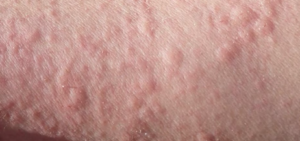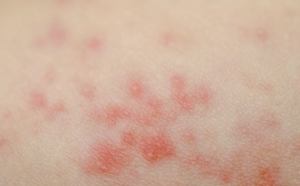Photodermatitis is caused by a variety of factors such as hereditary reasons, adverse response to some plants, drug side effects, etc. It is however a mild skin disorder and can be corrected with drugs, home remedies, and self-care.
Symptoms of photodermatitis
Photodermatitis patients may suffer from below listed signs and symptoms:
- Skin which is exposed to UV rays may experience adverse outbreaks
- Itchy elevated blotches, bumps, or blisters may form
- The anomalous rashes and patches on skin cause chronic itchiness
- Skin discoloration or darkening may occur in patches
- Photodermatitis lesions may appear like eczema rashes
- There may be dry and scaly abnormal areas on skin
- In chronic cases, the skin may become thick and elicit scarring
- Hives may also form
- Skin with photodermatitis blisters/rashes may elicit burning sensations
- Fever and chills, headache, nausea
- Pain, redness, swelling, and inflammation of affected skin areas
- If photodermatitis occurs due to genetic causes, then affected people may be more susceptible to developing skin cancer
Causes of photodermatitis
Some of the common causes of photodermatitis are mentioned below
- Underlying conditions
- Photosensitive reactions of skin may occur due to hereditary or metabolic triggers/factors, like pre-existing genetic conditions such as pellagra which is caused due to niacin and B3 vitamin deficits.
- Lupus, eczema, and other skin disorders can make the skin more photosensitive and trigger occurrence of photodermatitis.
- Conditions like polymorphic light eruptions, which are characterized by sensitivity to UV rays of sun, may also trigger photodermatitis
- Direct effect/Allergic reaction to chemicals and medicines
- Some types of chemicals and medicines can react to sunlight exposure and cause sunburn, hives, and eczema-like skin rashes. These reactions may occur due to direct contact with toxins released by substances, or it can occur as part of an allergic reaction.
- Direct poisonous effect may be observed after using medicines like antibiotics (sulfonamides or tetracycline); antifungals (griseofulvin, etc.); psoralens and coal tar derivatives used for psoriasis topical therapy; chemotherapy drugs/agents; retinoids (tretinoin) and acne medicines containing retinoic acid; NSAIDs; antimalarial medicines (quinine, etc.); diuretics; oral medicines for diabetes containing sulfonylureas; antidepressants (tricyclics, etc.); antipsychotics (phenothiazines); and anti-anxiety medicines (benzodiazepines).
- Photodermatitis causing allergic reactions may be observed after using certain perfumes; sunscreens containing PABA; Industrial/anti-bacterial cleaners or soaps containing hexachlorophene, salicylanilide; and certain plants with allergen components/compounds (limes, parsley, lemons, celery, parsnips, wild carrots, and figs)
The susceptibility to occurrence of photodermatitis may also increase in case of below listed triggers or risk factors:
- Patients with porphyria are at increased risk
- Contact with sunlight for more than 30 minutes, more so in spring and summer
- Exposure to bright sunlight that occurs between 10 AM and 2.30 PM; about 50% of UV sunlight radiation gets emitted during this period.
- People with fair or pale skin, green or blue eyes, or red or blonde hair have increased sensitivity to ultraviolet rays; this factor is not dependent on race or ethnicity. The incidence rate of photodermatitis in African-Americans and Caucasians is almost the same.
Treatment of photodermatitis
Photodermatitis is a mild condition and patients recover quickly with minimal treatment.
- If photodermatitis occurs due to some unexpected reaction, then clean skin rash with cold water to remove allergic agents. Cold water can also help find relief from itching, etc.
- Blistering or lesions that ooze need to be covered with wet and cool dressings.
- Calamine lotions and antihistamines can alleviate itchiness.
- Phototherapy, i.e., regulated exposure of skin to light for decreasing skin sensitivity and controlling symptoms, may be used for treating certain forms of photodermatitis. Doctors may suggest medicines like hydroxychloroquine, thalidomide, beta-carotene, or nicotinamide if phototherapy is not possible.
- Short-term dosage of glucocorticoids may help manage outbreaks.
- Severe sensitivity to sunlight may require immune system suppression via drugs like azathioprine.
- Consult doctor for alternative medicines if photodermatitis is triggered by use of certain drugs.
- If photodermatitis is triggered by nutritional deficits, then intake of a healthy, balanced diet along with supplements can help alleviate symptoms. Flavonoids and antioxidants are vital nutrients that protect skin from UV rays damage.
Follow the self-care guidelines listed below to prevent photodermatitis:
- Apply sunscreen with at least 30 SPF before going outdoors. Sunglasses, hats, shirts/tops with long sleeves, long pants, and other options to protect skin from UV rays are also recommended.
- The period between 10 am to 2 pm has the brightest sunlight. Avoid going outdoors during this time.
- Do not use tanning devices like a tanning lamp or a tanning bed
- Do not use cosmetics or other skin care products that raise skin sensitivity to UV rays.
Photodermatitis – Pictures



